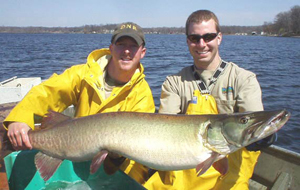LAKE WEBSTER HUSKY MUSKIE

DNR fish surveys this spring show the 774-acre natural lake in northeastern Indiana contains more than 5,000 adult muskellunge. A fair number of the trapped fish measured more than 50 inches long.
“That’s way more muskies than we originally thought were out there,” says DNR fisheries biologist Jed Pearson. Pearson and his crew recently completed a three-week long muskie trapping and tagging project at Lake Webster.
Between March 29 and April 14, DNR biologists set traps in Webster Lake to capture sexually ripe male and female muskies for the state’s muskie stocking program, to estimate the density of adult muskies in the lake, and to examine the fish’s long-term survival and growth rates.
The biologists caught 951 muskies at 13 different trapping sites. One trap in the northwest corner of the lake caught 299 muskie. Another trap in the northeast corner of the lake caught 210 muskie.
“We caught 72 muskie in one trap in just one day alone,” says Pearson. “That same trap produced 46 the day before and 28 the day after.”
Pearson says the density of muskie is more than six fish per acre. “Most lakes are considered good muskie lakes if they have one adult muskie per acre.”
Trapped muskie were measured, tagged with a small PIT tag inserted near the fish’s dorsal fin, and then released near the center of the lake.
PIT (passive integrated transponder) tags allow biologists to identify individual fish. By noting the number of tagged muskie recaptured during the trapping operation, biologists can mathematically estimate the overall number of muskie in a lake.
Muskellunge (nick-named muskie) are long, slim, predatory game fish native to the Great Lakes region and parts of the Mississippi and Ohio River drainage systems. The state-record muskie caught by a sport fisherman weighed 42.5 pounds. The average size of a muskellunge is 10-20 pounds.
Some muskie trapped by Pearson and his crew were kept to support the State’s muskie stocking program. In the fall and early winter, the DNR stocks a bunch of Indiana lakes with young muskie.
Northern Indiana muskie waters-
Ball Lake, Steuben County, Skinner Lake, Noble County, Loon Lake, Whitley County, Palestine Lake, Kosciusko County, Bruce Lake, Fulton County, Lake Webster, Kosciusko County, Tippecanoe Lake (Tippecanoe, James, and Oswego basins), Barbee Lakes (Kuhn, Big Barbee, Little Barbee, Irish, Sawmill, Banning, and Sechrist lakes).
The Webster Musky Club stocks Upper Long Lake in Noble County under a DNR stocking permit.
Southern Indiana muskie waters-
Brookville Lake, Franklin/Union Counties, Lake Waveland (first stocking in 2004), Montgomery County, Bass Lake, Greene-Sullivan State Forest, West and Black Cat Lakes,(first stocking in 2004), Greene-Sullivan State Forest, Plover and Sandpiper Pits, Driftwood State Fishing Area, Bartholomew County.
- Celebrating 20 Years Of Community At The Stand - April 12, 2024
- First Positive Case Of Chronic Wasting Disease In Indiana - April 12, 2024
- Southwest Allen County Schools Embark On Major Tree Plantings - April 12, 2024


